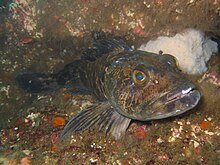Lingcod
| Lingcod | |
|---|---|
 |
|
| Ophiodon elongatus | |
 |
|
| At Santa Catalina Island, California | |
| Scientific classification | |
| Kingdom: | Animalia |
| Phylum: | Chordata |
| Superclass: | Osteichthyes |
| Class: | Actinopterygii |
| Subclass: | Neopterygii |
| Order: | Scorpaeniformes |
| Family: | Hexagrammidae |
| Genus: |
Ophiodon Girard, 1854 |
| Species: | O. elongatus |
| Binomial name | |
|
Ophiodon elongatus Girard, 1854 |
|
 |
|
| Range of the lingcod. | |
The lingcod or ling cod (Ophiodon elongatus), also known as the buffalo cod or cultus cod, is a fish of the greenling family Hexagrammidae. It is the only extant member of the genus Ophiodon. A slightly larger, extinct species, Ophiodon ozymandias, is known from fossils from the Late Miocene of Southern California.
Ophiodon elongatus is native to the North American west coast from Shumagin Islands in the Gulf of Alaska to Baja California, Mexico. It has been observed up to a size of 152 centimetres (60 in) and a weight of 59 kilograms (130 lb). It is spotted in various shades of grey. The lingcod is a popular eating fish, and is thus prized by anglers. Though not closely related to either ling or cod, the name "lingcod" originated because it somewhat resembles those fish. Around 20% of lingcods have blue-green to turquoise flesh.p.298 The colour is destroyed by cooking. The colour may be due to biliverdin, but this has not been established beyond doubt.
Lingcod are endemic to the west coast of North America, with the center of abundance off the coast of British Columbia. They are found on the bottom, with most individuals occupying rocky areas at depths of 10 to 100 m (32 to 328 ft). Tagging studies have shown lingcod are a largely nonmigratory species, with colonization and recruitment occurring in localized areas only.
Starting in October, lingcod migrate to nearshore spawning grounds. The males migrate first, and establish nest sites in strong current areas in rock crevices or on ledges. Spawning takes place between December and March, and females leave the nest site immediately after depositing eggs. Males actively defend the nest from predators until the eggs hatch in early March through late April.
The larvae are pelagic until late May or early June, when they settle to the bottom as juveniles. Initially they inhabit eelgrass beds, then move to flat, sandy areas that are not the typical habitat of older lingcod. They eventually settle in habitats of similar relief and substrate as older lingcod, but remain at shallower depths for several years.
...
Wikipedia
